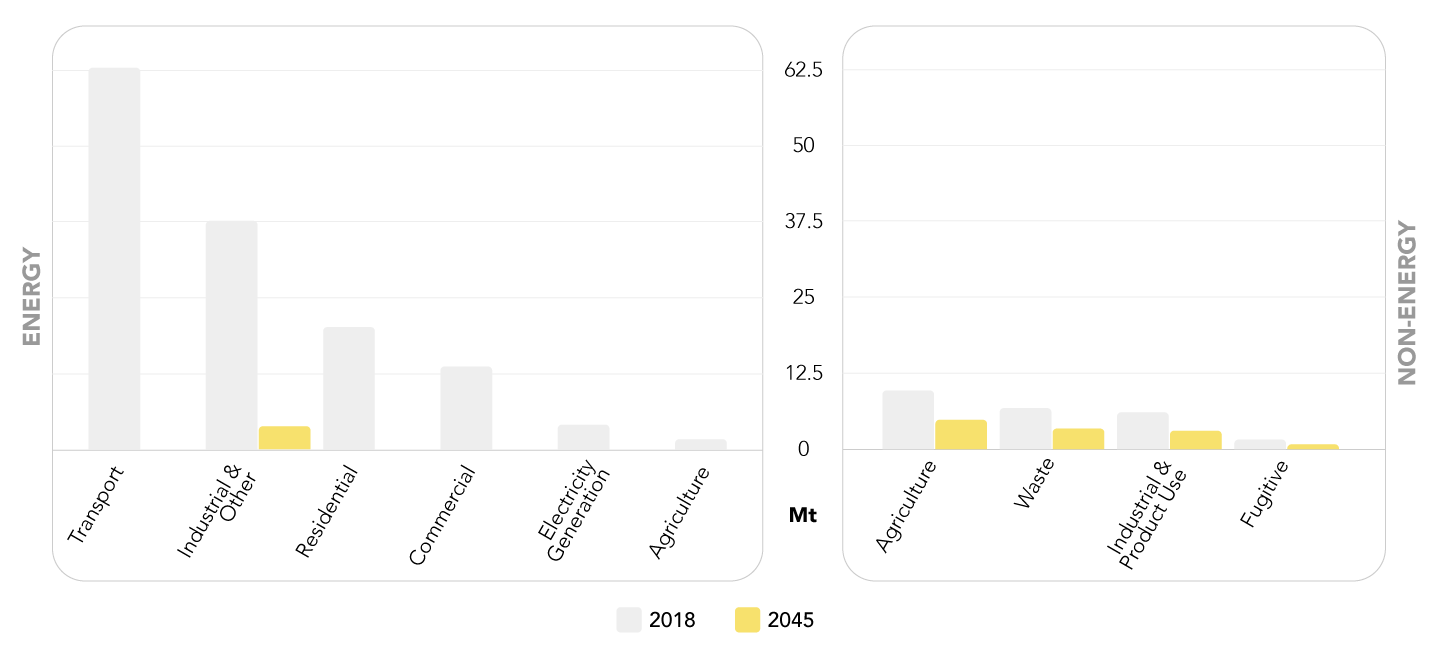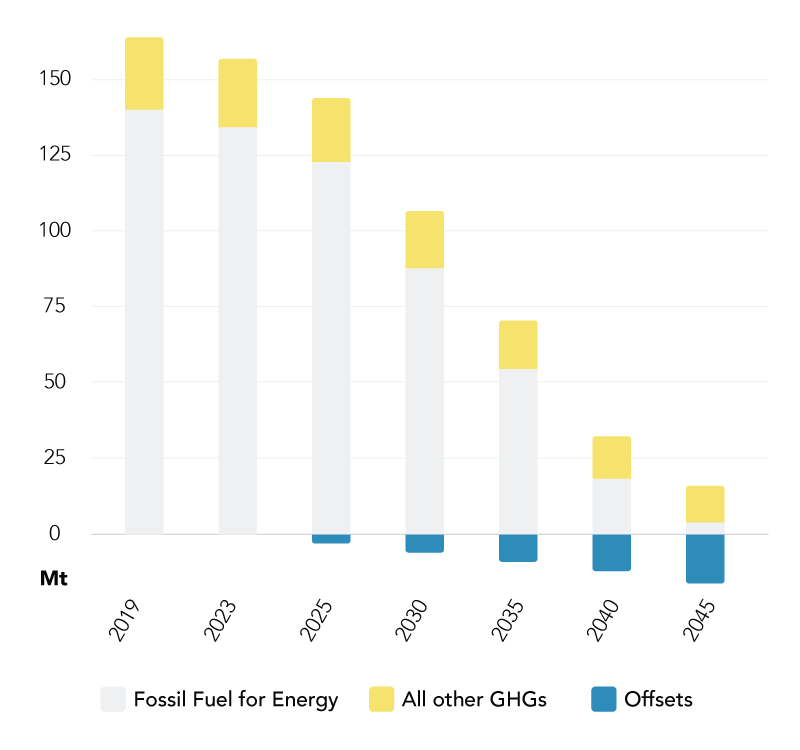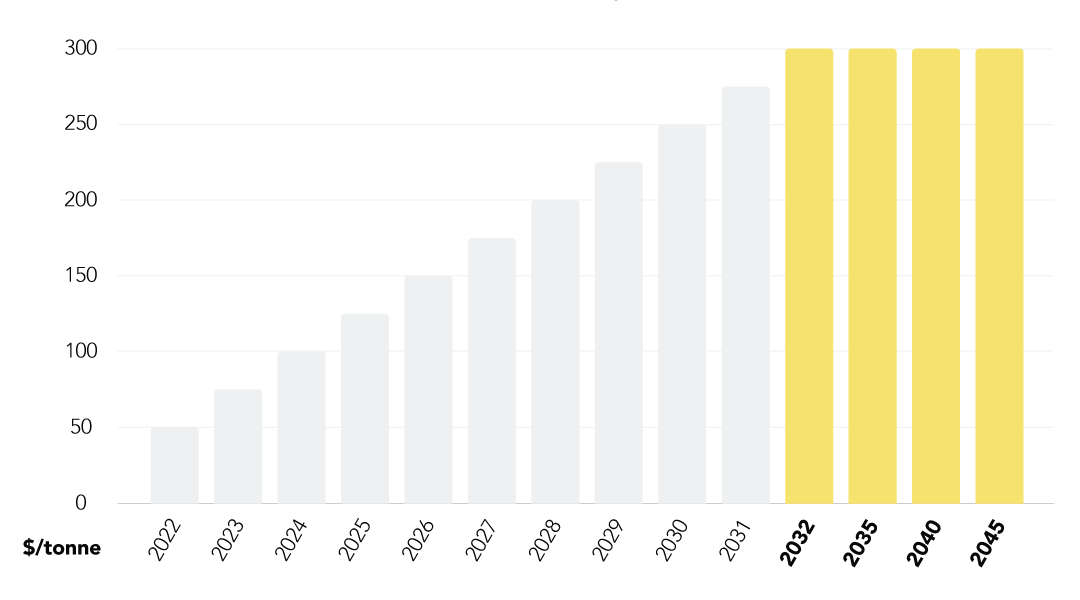Roadmap to Net-Zero
Our PrioritiesCrush Climate Pollution
#ClimateActionNow
Zero Carbon Law
Fair Share Carbon Budget
The Green Party will adopt a Zero Carbon Law that sets a Fair Share Carbon Budget for Ontario for the rest of this century. The law will:
- Keep Ontario within our fair share of the world’s total remaining carbon budget.
The International Panel on Climate Change (IPCC) says that, to keep a stable climate, the total amount of climate pollution people can release between now and the end of the century can be no more than 10 times what we now emit each year. For Ontario, this could not be more than total net emissions of 1,630 Mt, from now to 2100.
- Calculate how quickly Ontario must reduce emissions in order to stay within our Fair Share Carbon Budget while making the remaining emissions last as long as possible, ideally to 2045.
- Plan how to quickly reduce emissions as much as practicable using existing technology, while producing benefits such as better air quality, more jobs, new careers, stronger green businesses and reduced inequality.
- Emphasize rapid emission reductions.
- Count, at most, 10% offsets and sequestration towards our Fair Share Carbon Budget, with 90% achieved through real emission reductions.
- Steadily increase the price on carbon (climate pollution) by $25 per tonne per year, until the price reaches $300 per tonne by 2032.
- Create incentives for Ontario companies to be global leaders and job creators in the rapidly emerging zero carbon economy.
- Commit to public reports on annual net emissions and the remaining Fair Share Carbon Budget, just as the Ontario government must present an annual financial budget.
- Consult on additional measures to keep Ontario within our Fair Share Carbon Budget.
Reductions by sector
To stay within our Fair Share Carbon Budget, Ontario will have to use only what we need; switch from fossil fuels to electricity in transport, buildings, and most industries, and cut climate pollution from all other sources (such as agriculture, waste, and some chemical processes) by half. The likely transformation of each sector by 2045 is shown in the chart below.

Reductions by year
A possible reduction path for Ontario, beginning in 2023, could both help us stay within our Fair Share Carbon Budget to the end of the century and make some net emissions as late as 2045. This reduction path can be seen in the chart below.

Net-zero
Many claimed “offsets” are not permanent. Planting trees, for example, is valuable for many reasons, but no one can guarantee that the trees will survive 100 years, much less permanently. Many trees claimed as “offsets” have already burned in wildfires or succumbed to heat and drought.
This plan will be careful to only count offsets or removals that will keep climate pollution out of the atmosphere for at least 100 years.
What do we mean by net-zero?
Basically, “net-zero” means zero new climate pollution (principally greenhouse gas emissions from burning fossil fuels).
Climate change is driven by the total amount of climate pollution that humans release. Climate change will only stop getting worse when humans stop releasing new climate pollution.
“Net-zero” therefore means getting as close to zero greenhouse gas emissions as possible and offsetting any remaining emissions by permanently removing at least the same amount from the atmosphere.
Carbon Price
One key policy to achieve Ontario’s Fair Share Carbon Budget will be a carbon price that rises steadily, $25 per tonne every year, until it reaches $300 per tonne. The price will apply to as much as possible of the climate pollution that Ontario generates.

Why do we need a carbon price?
Without a carbon price, climate pollution seems “free,” stacking the playing field against the green economy, and requiring government to adopt detailed, intrusive and expensive regulations to take on the climate crisis.
With a carbon price, far fewer regulations are needed because businesses, families and innovators have a direct financial reason to move rapidly towards net-zero, have flexibility in how to do it, and have access to the infrastructure and supports they need.
Ontario already has a rising carbon price under the federal Greenhouse Gas Pollution Pricing Act. Ontario Greens will take over administration of the federal system and make it more effective by:
- Raising the price faster until it reaches $300/tonne in 2032.
- Eliminating gaps and exemptions.
- Reducing free climate pollution by heavy industries (see Clean energy and materials).
A steadily rising carbon price is a powerful tool, but it cannot do all the heavy lifting. The other policies described in this plan will work together with the carbon price to make the green transition succeed.
What will we do with the money raised from carbon pricing?
All carbon fee revenues collected from individual Ontarians will be returned to individuals as dividends, much as the current federal program does.
Carbon fee revenues collected from businesses will go to supporting businesses in the transition to net-zero.
Clean, safe ways to get around
We can reduce climate pollution and improve people’s lives by redesigning communities, by building accessible, fast and affordable public transit, by making streets safer for walking and cycling, and by giving everyone access to electric vehicles (EVs).
By moving aggressively to electrify transportation, Ontario will attract global investment to manufacture parts and assemble a range of electric vehicles, generating jobs and prosperity.
Ontario Greens will cut climate pollution from fossil-fuel vehicles in half by 2030 and virtually eliminate it by 2040:
- Dramatically increase access to electric vehicles (two-wheeled or more) and make them less expensive than fossil fuel powered vehicles, through feebates, rental systems, financing, and a Zero Emission Vehicles (ZEV) mandate.
- Ensure widespread access to electric vehicle charging.
- Give most Ontarians safe, accessible spaces for walking, rolling and biking to where they need to go.
- Triple public transit use by 2030, by making it clean, fast, convenient, reliable, affordable, and accessible.
- Improve low-carbon mobility in rural and remote areas.
- Electrify school, GO and transit buses.
- Phase out the sale of new gas and diesel-fueled passenger vehicles, medium-duty trucks, and buses by 2030.
- Build on Ontario’s strengths in mining, in innovation, in financing and in auto manufacturing to build a strong Electric Vehicle manufacturing strategy and electric transportation industry supply chain.
Did you know?
Gas- and diesel-fueled vehicles are Ontario’s largest climate polluters. They harm health and damage communities through dirty air, collisions and congestion and by dominating public space. Plus they cost more to operate than electric vehicles.
Clean, comfortable buildings to live and work in
Incentives for green building retrofits will create jobs, reduce climate pollution and help people save money by saving energy.
To cut fossil fuel use in buildings 50% by 2030 and to net-zero by 2040, we will:
- Create over hundreds of thousands of new jobs by retrofitting 40% of existing homes and workplaces to net-zero (conservation plus heat pump or non-fossil-based district energy) by 2030 and 100% by 2040.
- Set a Gas Footprint Standard to slightly reduce the carbon footprint of fossil gas heating fuel.
- Eliminate fossil fuel use in new and renovated government buildings by 2025, and in all government buildings by 2030.
- Amend the Building Code, so all new commercial and residential buildings and additions are zero-emission and resilient by 2028 and are built with the lowest carbon footprint possible.
- Make building-level fossil fuel use transparent through labelling and disclosure.
For more details, see gpo.ca/climate/energy.
Did you know?
Burning fossil fuels (mostly so-called “natural” gas) to heat buildings is Ontario’s second-largest source of climate pollution. Sustainable homes are more comfortable, less costly to heat and cool, and less prone to harm from extreme weather.
Strong communities have a wide variety of different kinds of housing, enough population density to support transit, ample public greenspace and a vibrant mix of land uses so that people may live, work, play, shop, and worship in their own neighbourhood.
To build strong, affordable communities while stopping sprawl, Ontario Greens will:
- Freeze urban boundaries.
- Accelerate construction of infill housing, particularly missing middle and affordable housing, and public greenspace.
- Stop new subdivisions on farmland, wetlands or forests, and smartly expand the Greenbelt.
- Redirect provincial funding away from infrastructure that promotes sprawl, and toward infrastructure that supports compact, clean, connected communities.
- Repair all of the Conservative government’s damage to land use laws, and to growth planning, including restoring powers to Conservation Authorities to allow them to protect provincially significant wetlands and other areas, reversing misuses of Ministerial Zoning Orders (MZOs), and reversing plans that force municipalities to prepare for sprawl.
- Eliminate subsidies for sprawl from property tax and development charges.
For more details, see gpo.ca/climate/community.
Clean energy and materials
Clean energy, used only when we need it, is the foundation of a green economy. Burning fossil fuels hurts everyone.
To clean up energy, the Ontario Greens will:
- Eliminate fossil fuels from electricity generation the fastest way compatible with our fair share carbon budget, aiming to phase out fossil gas by 2030.
- Double Ontario’s electricity supply with renewables, storage (including Green Hydrogen) by 2040, and make Ontario’s electricity emission-free as quickly as possible.
- Electrify everything practicable (including buildings, transport and 90% of industrial energy,) directly or via green hydrogen made with clean electricity.
- Provide easy financing so people and businesses can install clean, high-efficiency electric equipment, e.g. air and ground source heat pumps.
- Support Ontario clean tech innovators. By showing global leadership, we can attract international investment again, create new careers with better jobs and help build a robust economy.
- Begin work with Indigenous Peoples to site essential electricity transmission lines.
- Level the playing field by redirecting subsidies away from fossil fuel use.
- Stop fossil fuel lock-in. Stop building new fossil fuel pipelines and close dangerous pipelines.
- By 2025, stop new fossil gas hookups and new gas furnaces, boilers, stoves, and water heaters.
For more details, see gpo.ca/climate/energy.
To clean up materials and products, the Ontario Greens will:
- Use incentives and government procurement to support Ontario entrepreneurs to build world-leading clean businesses and careers, especially in energy storage (e.g. batteries), electric/ fuel cell mobility, smart transit and low-carbon biomaterials.
- Build on Ontario’s strengths in mining, in innovation, in financing and in auto manufacturing to build a strong electric transportation industry supply chain.
- Demand that the federal government establish border carbon adjustments to establish a level playing field for Ontario’s low-carbon producers.
- Set strict standards for polluting industries, and help them meet them through low-interest loans, Ontario Centres of Excellence, collaboration with clean-tech solution providers and public procurement.
- Help small- and medium-sized businesses transition to the green economy through financial incentives and grants.
For more details, see gpo.ca/climate/materials.